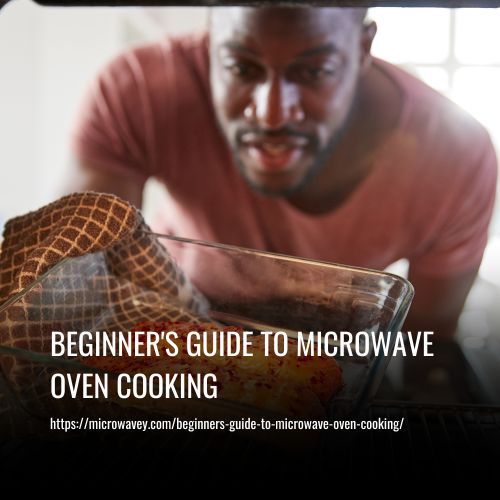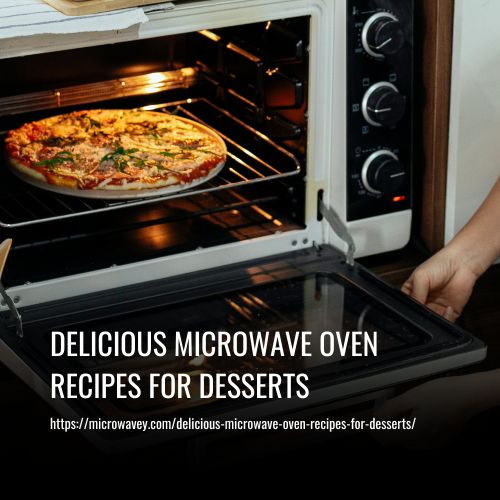Beginner’s Guide To Microwave Oven Cooking
Cooking with a microwave oven may seem intimidating and daunting, but it doesn’t have to be! With a few simple tips and tricks, you can start microwaving delicious meals in no time.
In this beginner’s guide to microwave oven cooking, we’ll show you how easy it is to create tasty dishes without ever turning on your stove or oven.
From popcorn to stir-fries, there are countless recipes that can be made quickly and easily in the microwave. We’ll provide step-by-step instructions for each dish so you don’t need any special skills or experience – just an appetite for good food!
You’ll also get helpful advice on selecting the right ingredients, choosing cookware, checking temperatures, and more.
So grab your spatula and let’s get cooking!

Microwave Safety
Every year, thousands of households are affected by the danger associated with microwave ovens. Whether from a small spark or an unexpected fire, too many people underestimate the potential for injury when using this appliance.
To ensure safety in the kitchen, it is essential to understand how to prevent burns and avoid fires while cooking with microwaves.
When operating any kind of stovetop or oven, having the right protective equipment on hand is key. For microwaves, be sure to use potholders that can withstand high temperatures and keep all combustible materials away from the machine’s surface.
Similarly, never leave food unattended in a heated microwave as it could catch on fire if left alone long enough. Additionally, be mindful not to overheat oil or butter because these ingredients can ignite quickly when exposed to extreme heat.
Learning proper maintenance techniques will also help keep your family safe when preparing meals in a microwave. Make sure to clean up spills immediately after they occur and inspect the door seals often for signs of damage or wear-and-tear which might cause hazardous sparks during operation.
Lastly, read through your manual upon purchase so you know exactly how your model works and what not do while cooking inside it – this way you’ll stay informed and equipped with all necessary knowledge needed!
Choose The Right Cookware
Now that you understand the safety precautions to take when using a microwave, it’s time to learn more about what kind of cookware is appropriate for your kitchen appliance.
To ensure success in cooking with your microwave oven, choose items made from glass, ceramic or plastic – all of which are specifically designed for use in microwaves. Avoid metal containers as these can cause sparks and dangerous arcing inside the oven.
When selecting cookware, consider the shape and size of the container relative to the food you plan on making. Make sure there’s enough room between ingredients so heat can circulate evenly throughout the dish during cooking. It will also help reduce overall cooking time and maximize power output while heating up food quickly and efficiently.
Additionally, make sure any lids or covers fit snugly onto your cookware — this prevents splatters from occurring inside your microwave oven.
Mastering Microwave Settings
Cooking with a microwave oven is like taking a magical journey into the world of culinary possibilities. With just a few simple settings, you can master your way to delicious and nutritious meals in no time.
When it comes to defrosting food or steaming vegetables, there’s nothing quite like having the convenience and control of using a microwave. Defrosting food requires specific heating patterns that are delivered quickly while steaming veggies gives them an extra boost of flavor without needing to boil water on the stovetop.
The trick is understanding how long each setting should be used for optimal results – but don’t worry too much about it! Once you get the hang of things, you’ll be surprised at how easy it is to customize your cooking experience.
You now have all the tools necessary to create tasty dishes with ease in your very own kitchen. Whether you’re looking for a quick meal solution or something more complex, mastering microwave settings will help make every dish come out perfectly cooked and full of flavor.
So go ahead, experiment and enjoy!
Reheating Leftovers
Reheating leftovers is one of the most common uses for a microwave oven. It’s an easy way to save time and energy when you need a quick meal on the table. Plus, it’s often just as tasty – if not tastier – than eating something fresh!
When storing leftovers, be sure to use airtight containers or plastic wrap that are safe for microwaves. This will help keep food from drying out and increase its shelf life.
As always, make sure your food is thoroughly reheated before serving so that any bacteria present have been killed off. If possible, separate sauces in the container and warm them up separately after heating the main dish; this keeps flavors fresher longer.
Microwave ovens can be used for much more than just reheating leftovers — but being able to quickly and easily heat up what you already have cooked definitely makes a busy day easier! And remember: food safety is key when it comes to storage and reheating practices.
Preparing Frozen Foods
Cooking frozen food can seem like a daunting task, but with the right tools and techniques, it’s easy to make delicious meals that are sure to impress.
Take defrosting meats for example. If you’ve ever tried to do this in the past using traditional methods, such as leaving them out on the counter or submerging them in water, you know how long of a process it can be – not only is it time-consuming, but there’s also no guarantee that your meat will end up evenly thawed.
With a microwave oven however, all you need to do is turn down the power level setting and let it go! This way, your meal will be ready in minutes without any inconsistencies or surprises.
Steaming vegetables is another great use for microwaves when cooking frozen food. Not only does steaming help preserve flavor and texture more than boiling, but it also helps retain much needed nutrients which otherwise could get cooked away if done incorrectly.
To steam vegetables with a microwave oven simply place them into an appropriate container and add just enough liquid so they won’t dry out during cooking. Once everything is set up properly cover tightly with plastic wrap and cook until desired doneness.
The result? A healthier dish packed full of flavor!
Making Popcorn
Choosing the right popcorn is key to making a delicious batch. Look for popcorn that’s non-GMO and air-popped for the best flavor.
Popping the popcorn in the microwave oven is a quick and easy process. Just add the kernels to the bowl, cover with a lid, and set the timer!
Choosing The Right Popcorn
When it comes to making popcorn, many people opt for the convenience of a microwave. But, if you want that perfect bowl of fluffy and delicious corn, there’s one more important step – choosing the right popcorn!
Whether you’re popping kernels on the stovetop or in the microwave, picking out an ideal variety is key. Look for pre-packaged flavored popcorns like cheddar cheese or caramel butter as they often make movie night even better. Or go classic with plain popped kernels – either way your snack will be poppin’!
Keep in mind that some popping methods require specific types of popcorn, so read up before selecting your bag. With these tips in mind, you can now enjoy perfectly made popcorn anytime!
Popping The Popcorn
Now that you’ve chosen the right popcorn, it’s time to start popping! Depending on the type of cooking method, there are different techniques and tools to use.
For stovetop popping, a large pot with an airtight lid is ideal for preventing burning or exploding kernels. If you’re using a microwave, just add your desired amount of kernels into a paper bag and pop away! Be sure to follow any instructions printed on the packaging for best results.
Once your corn has finished cooking, transfer it into a bowl and get ready to serve up some deliciousness. A few serving suggestions include adding sprinkles of salt and butter or creating unique toppings like parmesan cheese, cayenne pepper or even chocolate chips!
With all these options in mind, you can now enjoy perfectly-popped popcorn anytime!
Cooking Eggs
Making popcorn is a great way to snack on movie night, but if you want something more substantial then cooking eggs in the microwave could be just what you need.
Crackling bacon and scrambled eggs are timeless classics that can be whipped up with ease – all thanks to your trusty microwave oven!
To get started, begin by lightly greasing the inside of a large bowl or mug with butter or non-stick spray. Next, crack two eggs into the bowl along with some salt and pepper for seasoning; whisk everything together until it’s well blended.
You can also add some diced vegetables like bell peppers or onions as well as crumbled bacon pieces for extra flavor.
Microwave the mixture at medium power level for one minute, give it a stir, then heat again for another 30 seconds until cooked through.
Serve hot alongside toast and enjoy!
Making Stir-Fries
Cooking a delicious stir-fry is like painting a masterpiece. It requires the right ingredients, careful planning, and swift execution of each step to achieve the desired outcome.
With an arsenal of flavorful sauces at hand and your microwave oven’s even heat distribution providing the perfect canvas for your culinary endeavor, you can create something both beautiful and mouthwatering.
Start by prepping all your vegetables ahead of time – this will help ensure that everything cooks evenly when it’s time to put them in the pan.
When selecting which sauce to use for your stir fry dish, let taste be your guide; there are dozens of options out there ranging from sweet & sour to spicy sesame oil sauces!
Once you’ve got everything ready to go, add some oil into the microwavable dish along with the vegetables – but don’t forget about seasoning either.
Finally, pop it in the microwave on high power for several minutes until they’re cooked through and serve while hot.
Baking Cakes And Muffins
Baking cakes and muffins in a microwave oven is an easy way to get delicious treats without heating up the whole kitchen.
Cakes can be iced before or after baking with great results, while meats such as casseroles and stuffed peppers will come out perfectly browned when cooked in the microwave.
It’s important to pay attention to cooking times for your favorite recipes so you don’t end up with either over-cooked or underdone food.
Start by setting the timer for just a few minutes less than recommended, then check on it periodically until it looks done.
This allows you to adjust the power level of the oven if needed, ensuring that your desserts are moist and flavorful, and your meats are perfectly browned.
With some practice, you’ll soon become an expert at creating wonderful meals in your microwave oven!
Checking Temperatures
Temperature is an essential factor when it comes to successful cooking in a microwave oven. It’s all about timing accuracy, and making sure you adjust your settings correctly for the best results.
To check whether food is cooked properly, use either a digital thermometer or a smaller piece of food from within the dish itself. The temperature should read at least 75°C (165°F) before removing the item(s) from the oven.
Pay attention to any changes you make to ensure that your meal turns out as expected.
Keep in mind that some ingredients will require different temperatures than others, so be sure to look up specific times and temperatures according to what type of food you’re working with.
For example, poultry needs to reach 74°C (165°F), fish needs 59–63°C (140–145°F), while vegetables may only need around 60–65°C (140-150°F).
With this knowledge, plus having confidence in setting adjustments, you can become a master of microwave cooking!
Conclusion
If you’re still feeling intimidated by the thought of using your microwave oven, don’t worry. With a few simple tricks and tips, you can become an expert in no time! I’m here to show that cooking with a microwave is not only easy—it’s fun too.
The first step is to get comfortable with the basics: safety precautions, cookware choices, setting options and reheating leftovers. Then it’s time to move on to more adventurous dishes like eggs, stir-fries and even cakes or muffins. You’ll be amazed at what your microwave can do! Just remember to check temperatures before serving any dish for best results.
Once you feel confident navigating your way around the appliance, you can start experimenting with different recipes and techniques.
Picture yourself making fluffy omelets or perfectly cooked vegetables in minutes—all without turning on the stovetop. What could be better?
So go ahead, give it a try! Your taste buds will thank you later.



